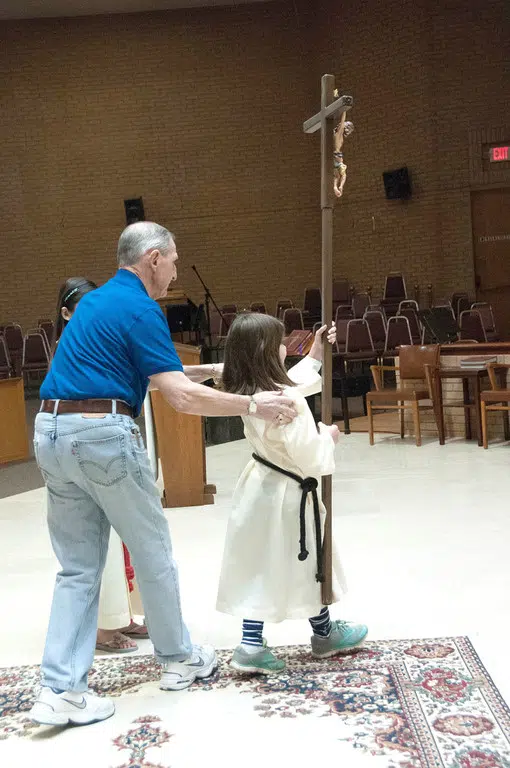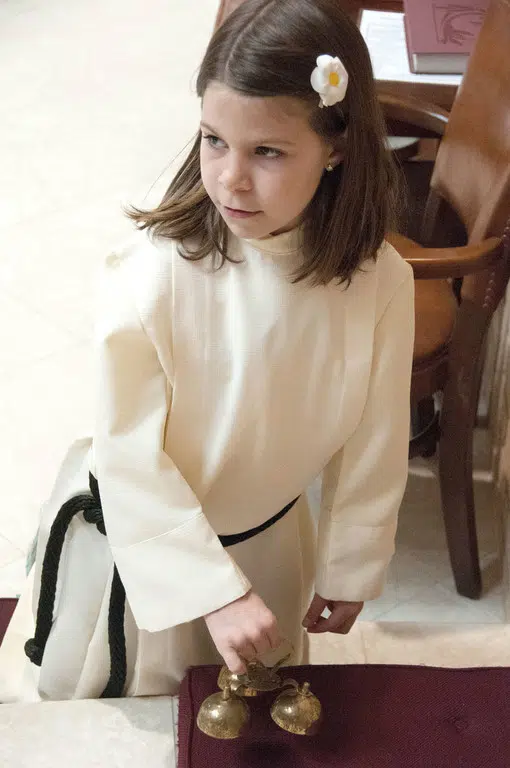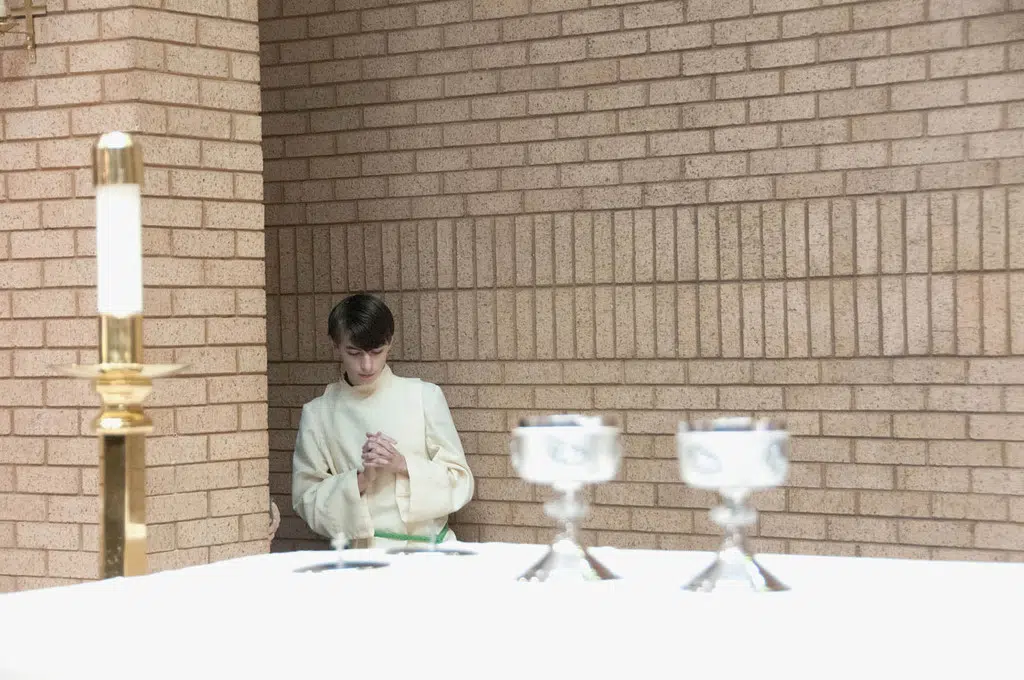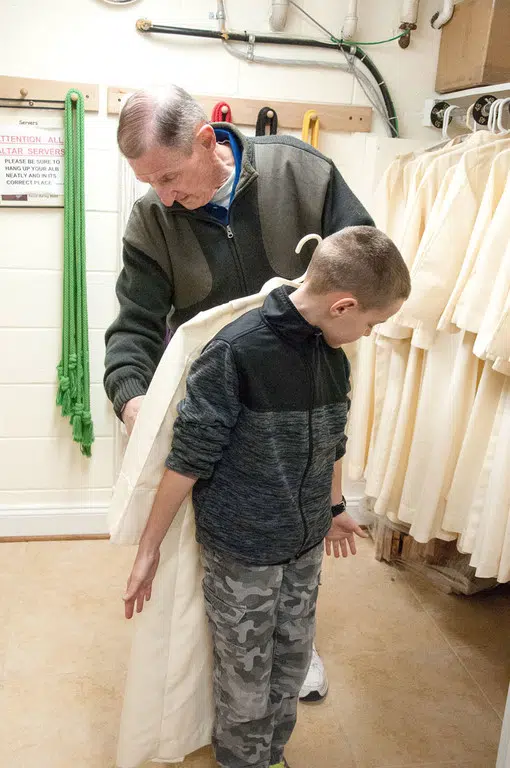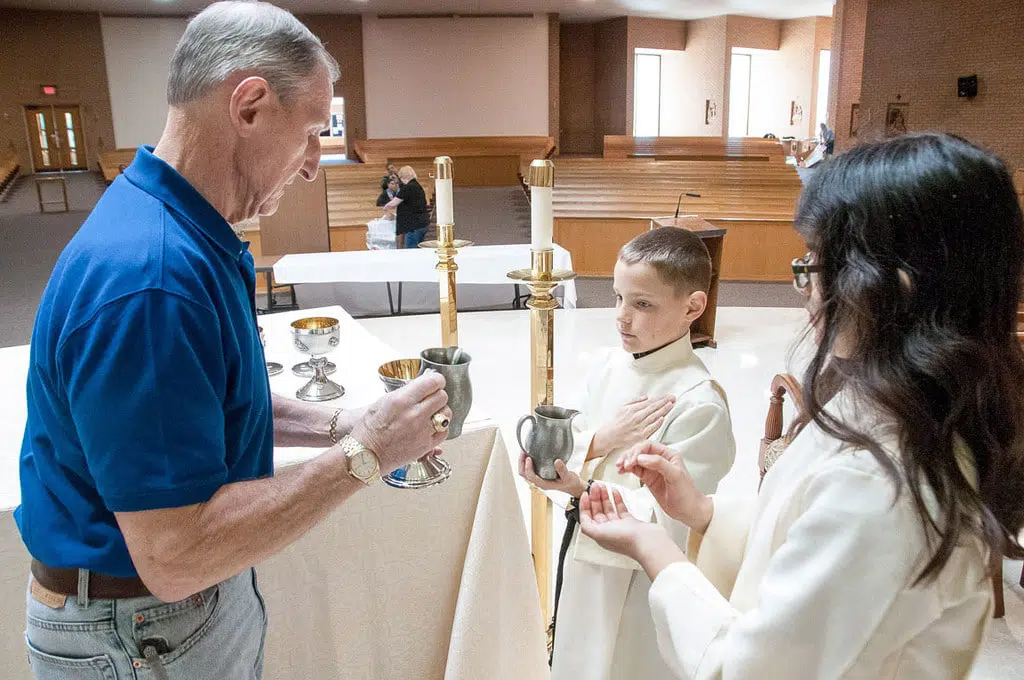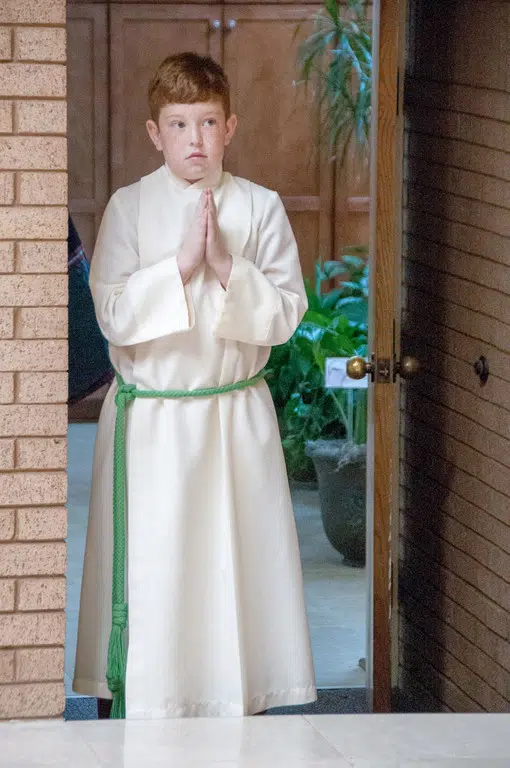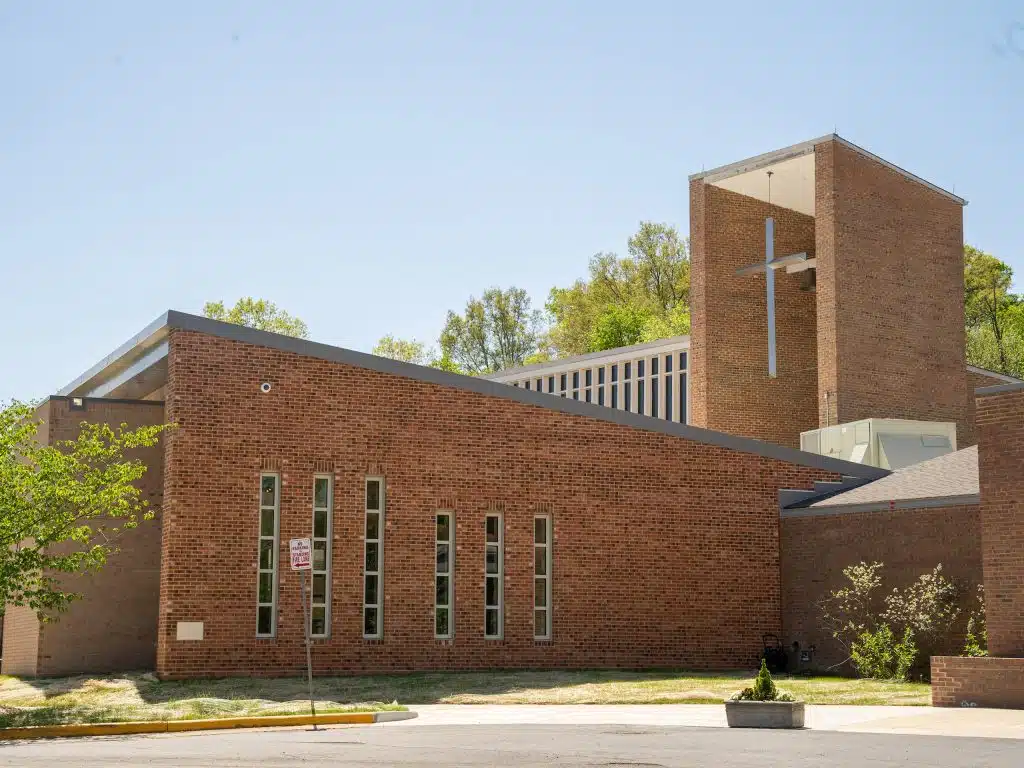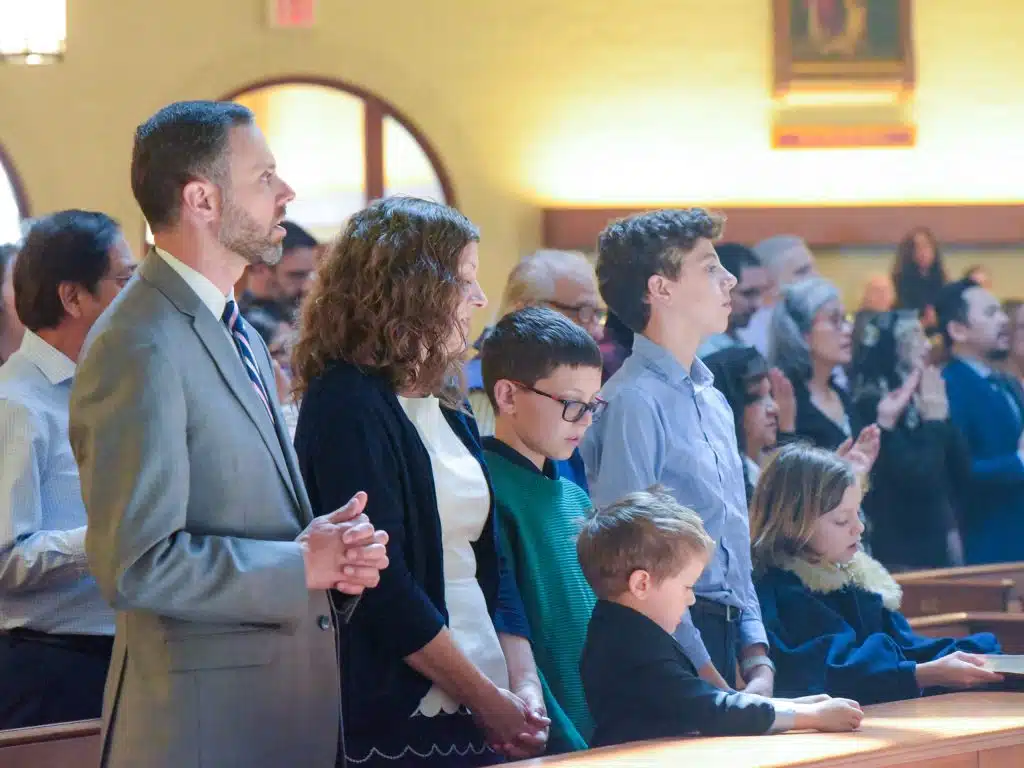They light candles and ring bells, carry the crucifix and
hold the missal. In great cathedrals and modest chapels,
altar servers perform simple yet essential acts in service to
the heart of the Catholic faith – the sacrifice of the Mass.
If they are doing their job correctly, servers are at once
invisible assistants and vital leaders, said Larry Cerruti,
who has trained altar servers at the Cathedral of St. Thomas
More in Arlington for more than two decades. The priest
represents Christ, and the servers are helping the priest,
said Cerruti, “but they are also representing us, the
community, and they lead us in prayer.”
Before donning an alb or cassock for Mass, servers undergo
extensive training, learning about the structure of the
liturgy and mastering numerous responsibilities. In the
Arlington Diocese, their instruction varies from parish to
parish, but the trainers have a similar desire for the
youths.
“My hope,” Cerruti said, “is that whatever vocation they
chose in life, that this will cultivate lifelong prayer,
devotion and great fervor for their faith.”
Mechanics with meaning
It was early on a Saturday morning, but Ryan Minogue, 9, was
wide awake and smiling as he slid into a pew at St.
Bernadette Church in Springfield. As one of 16 young
parishioners in the final stages of altar server training, he
was eager to walk through the Mass with his fellow trainees.
“I’ve always wanted to be an altar server,” said Minogue.
“It’s hard work, though, remembering everything.”
Although parishes have different approaches to training
servers, all follow U.S. Conference of Catholic Bishops
guidelines. According to the guidelines, altar servers must
have received their first holy Communion and “be mature
enough to understand their responsibilities and to carry them
out well and with appropriate reverence.”
It’s a “fairly even split” between parishes that have both
male and female servers, like St. Bernadette, and those that
have only male servers, according to Father Paul F.
deLadurantaye, diocesan secretary for religious education and
sacred liturgy.
After the Vatican approved the use of female altar servers at
Mass in 1994, the decision to implement the change on a
diocesan level was left to each bishop’s discretion. In 2006,
Arlington Bishop Paul S. Loverde told pastors they could
include girls as altar servers or maintain male-only servers.
For the past decade at St. Bernadette, servers have been
under the gentle direction of Jay Conners.
Conners divides training into four segments, which can extend
into a total of 12 hourlong Saturday sessions. “It depends on
how many kids there are and how quickly they learn,” he said.
Each segment covers a different portion of the Mass. The boys
and girls learn about the procession, memorizing how to
approach the altar, where to store the crucifix and candles,
and what chairs to sit in. Next they are taught when to hold
the candles for the Gospel.
The third and busiest section covers the Liturgy of the
Eucharist, when servers bring the chalice, ciborium (a
cuplike vessel containing the hosts), the crucifix and
candles. “Everyone has something to do,” said Conners. The
final segment covers the end of Mass.
At the cathedral, Cerruti trains boys in three two-hour
classes. After a general orientation, he guides the servers
through the mechanics of the Mass.
But the boys are not like waiters at the altar, and the goal
is not simply to have them master when to go where. “The more
comfortable they are in the mechanics, the better they can
participate prayerfully in the Mass,” said Cerruti, adding
that leading the congregation in prayer through example is a
key responsibility of the ministry.
Before serving at a Sunday liturgy, Cerruti places the boys
in an internship period, where they serve alongside
experienced servers at weekday Masses.
According to the USCCB guidelines, two or more servers should
assist at Sunday Masses.
Father James C. Hinkle, parochial vicar of St. Theresa Church
in Ashburn, begins altar server training with one session “to
establish the groundwork,” and then offers training to boys
several times a year to build on their knowledge.
The first step is to help servers appreciate “the theology of
the Mass,” said Father Hinkle, who helped create an altar
server training and recruitment video featuring an
introduction by Bishop Loverde.
“I want them to grasp what cannot be seen. (Because) once
they understand what is going on in the sanctuary it gives
them a more organic respect for the Mass,” Father Hinkle
said.
The training and the dress code are different at each parish,
but all are intended to promote reverence among the servers
and minimize distraction during Mass. Boys and girls may not
wear jeans, sneakers or open-toed shoes at St. Bernadette;
boys serving at St. Theresa must wear black socks, shoes and
pants.
To serve and inspire
Since the early church, young people have assisted at Mass
and received countless spiritual benefits from the ministry,
including discerning vocations to the priesthood and
religious life.
According to Georgetown University’s Center for Applied
Research in the Apostolate, 80 percent of priests ordained in
2014 were one-time altar servers. Of the women and men
entering religious life the same year, more than a third were
either extraordinary ministers of holy Communion or altar
servers.
Father Hinkle was an altar server, and he credits a “good
portion” of his vocation to serving. The ministry shows young
men what being a priest is like, he said.
But even for those not called to a priestly or religious
vocation, said Father deLadurantaye, service at the altar can
enhance young people’s prayer life, their participation in
the sacramental life of the church and their desire to give
of themselves.
Altar servers often know more about the faith than many adult
Catholics, Cerruti added. They learn, for example, that
Kyrie, eleison (Lord, have mercy) – part of the Act of
Penitence at the beginning of Mass – is Greek, not Latin.
The training youths receive is an opportunity to “learn the
faith from the inside,” said Cerruti, who, along with Father
Hinkle and Conners, has a deep affection for and pride in his
servers.
They are “a dedicated bunch of kids,” Cerruti said. Be it
rising at 6 a.m. to serve a 7 a.m. liturgy or giving up a
Saturday evening for a vigil Mass, they “put a lot of
themselves into it.”
At St. Bernadette, as altar server trainees filed into the
sacristy to put on their albs, Minogue was the first in line.
“I think it’s so cool to help the priest,” he said. “And to
be able to serve people and to maybe inspire them, that’s
what I want to do.”
Watch the video
To see a video created at St. Theresa Church in Ashburn on
altar serving, go here.
Altar server prayer
Open my mouth, O Lord, to bless Your holy name.
Cleanse my heart from all evil and distracting thoughts.
Enlighten my understanding and inflame my will that I may
serve more worthily at Your holy altar.
O Mary, Mother of Christ the High Priest, obtain for me the
most important grace of knowing my vocation in life.
Grant me a true spirit of faith and humble obedience so that
I may ever behold the priest as a representative of God and
willingly follow Him in the way, the truth and the life of
Christ.
Amen.
